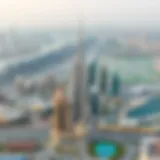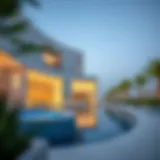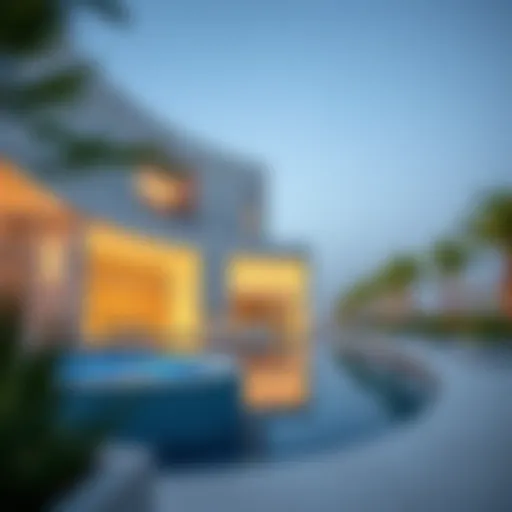Burj Khalifa: An In-Depth Exploration of Its Height
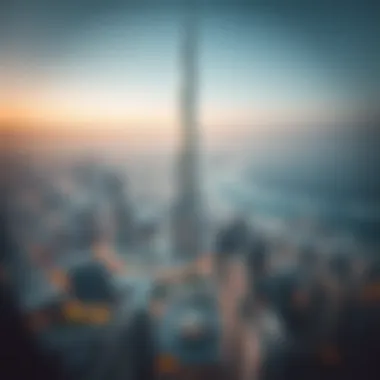
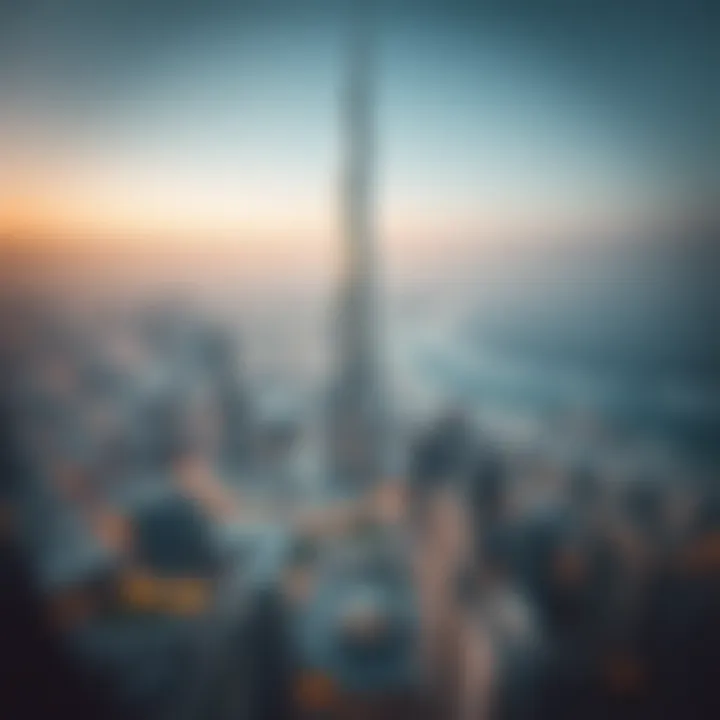
Intro
The Burj Khalifa, towering at an astounding height of 828 meters, is more than just a skyscraper; it stands as a testament to human ingenuity and architectural ambition. Nestled in the heart of Dubai, this architectural marvel captures the imagination of all who behold it. It’s not just a structure, but a cultural icon, embodying the essence of a rapidly evolving city known for its extravagant skyline and dynamic real estate market.
In this comprehensive analysis, we will navigate through the intricate layers of the Burj Khalifa’s significance. From its meticulously crafted design and the engineering feats that enabled its construction to its impact on Dubai's burgeoning real estate landscape, this article aims to provide a detailed examination. Each section will unveil the nuances of this skyscraper, analyzing its height in relation to urban development and tourism, while also considering the broader implications its stature brings to the market surrounding it.
The popularity of the Burj Khalifa has catalyzed trends in real estate, drawing investors and homebuyers from around the globe. As we delve deeper, we will explore how the iconic height of this building intertwines with market trends and investment opportunities that arise in Dubai, making it not just a landmark, but an essential focal point for understanding the Emirate's growth in property values and investment potential.
Prelims to Burj Khalifa
The Burj Khalifa stands tall, both literally and figuratively, as more than just another skyscraper in the desert. It is a beacon of innovation, ambition, and architectural greatness. As the tallest building in the world, its significance stretches beyond its staggering height of eight hundred twenty-eight meters. This section will delve into its importance, the implications of its grandeur, and the narrative it spins in the context of modern architectural endeavors.
Overview of Its Significance
From the bustling streets of Dubai to the far corners of the globe, the Burj Khalifa has etched itself into the collective consciousness as a symbol of what human ingenuity can achieve. Its presence serves several key functions:
- Tourist Attraction: Every year, millions flock to this architectural wonder, eager to witness the view from the observation deck. The Burj Khalifa not only contributes to Dubai’s economy through tourism but also establishes the city as a global travel hotspot.
- Cultural Icon: The tower signifies the rapid growth and modernization of Dubai. It reflects the city’s transformation from a small fishing village into a bustling metropolis, embodying the spirit of progress.
- Architectural Benchmark: Engineers and architects worldwide study its design and structure. The Burj Khalifa showcases best practices in height, sustainability, and technology.
In summary, the Burj Khalifa holds its ground as a fusion of style, function, and symbolism, making it a vital study for investors, architects, and tourists alike.
A Brief History of Construction
The story of the Burj Khalifa's construction is as tall as the building itself. Initiated in 2004 and completed in 2010, the project underwent numerous phases, involving thousands of workers and a multitude of materials.
To fully appreciate what it took to erect this icon, consider some key facts:
- Design and Planning: Designed by the renowned firm, Skidmore, Owings & Merrill, the tall structure was expertly crafted to withstand the harsh climate and high winds of Dubai.
- Construction Duration: The build took around six years, involving over 10,000 workers at its peak. It was a complex dance of logistics, materials, and manpower to bring the structure into existence.
- Innovative Techniques: The team incorporated cutting-edge construction methods, using high-strength concrete to enable such an unprecedented height, ensuring safety and stability throughout the tower.
"The Burj Khalifa's completion marked a monumental achievement in engineering and architecture; it was a dream crafted into reality, redefining possible limits."
Familiarizing oneself with the Burj Khalifa's roots enhances one’s comprehension of its current standing, framing its narrative and relevance in today’s urban landscape.
Height Specifications
Height is not merely a number when it comes to architectural landmarks; it embodies the ambitions of a city and speaks volumes about what is deemed possible within the realm of human creativity and engineering. In the case of the Burj Khalifa, this aspect holds significant weight for several reasons. Firstly, the building's height sets a benchmark for future skyscrapers and pushes the boundaries of vertical architecture. Investors and real estate developers frequently analyze such features when considering projects that might challenge or emulate its record-breaking status. Additionally, the height informs the building's role within the urban landscape, influencing skyline aesthetics and potentially driving tourism. As the saying goes, "the sky's the limit," and the Burj Khalifa sets a new sky altogether.
Official Height: Eight Hundred Twenty-Eight Meters
Standing proudly at a height of eight hundred twenty-eight meters, the Burj Khalifa is officially recognized as the tallest building in the world. But why is this specific height important? For one, it symbolizes not just physical elevation but also the aspiration of Dubai to establish itself as a global hub for tourism, business, and innovation. This figure is not just a technical specification; it serves as a marketing tool as well, attracting millions of visitors eager to experience what it feels like to stand atop the very tallest of buildings.
Moreover, the height comes with rich engineering challenges and solutions that need careful consideration. The engineers and architects who designed this skyscraper have valued every single meter, ensuring it provides maximum functionality while achieving aesthetic brilliance. The twelve hundred and ninety-three feet of steel and concrete are not just for show; they house residential spaces, corporate suites, and comprehensive amenities, laying a foundation for a lifestyle that thrives at dizzying heights. People often wonder how this towering structure has been able to stand amid the desert's strengths and challenges—knowledge about its actual height reveals a great deal about the innovative methodologies in construction employed to meet these hurdles.
Comparative Heights with Other Structures
When placing Burj Khalifa in the context of other tall buildings, its height might make others seem diminutive. To offer a perspective:
- Empire State Building (New York): At 381 meters, the Empire State Building was the tallest building in the world until it was surpassed by the Burj Khalifa. Its history is rich, but the Burj exhibits a more avant-garde approach.
- Shanghai Tower (China): Standing at 632 meters, it ranks second, yet still falls short of the pinnacle the Burj Khalifa has achieved.
- Abraj Al Bait Clock Tower (Mecca): Almost as tall at 601 meters, it represents another instance of towering ambition but doesn’t match up in height.
Through these comparisons, it becomes evident that the Burj Khalifa doesn’t just stand above others in inches but rather in the colossal ambition it represents for urban development worldwide. The implications of its towering presence drive economic, social, and architectural conversations across global forums.
"In towers, as in peace, it is height that brings clarity and vision."
In summary, the height specifications of the Burj Khalifa are pivotal not merely as numbers but as measurements of aspiration, design, and economic impact. Understanding this allows investors, homeowners, and analysts alike to appreciate not just the architectural feat itself, but also the myriad considerations that come with creating such a monumental structure.
Design and Architecture
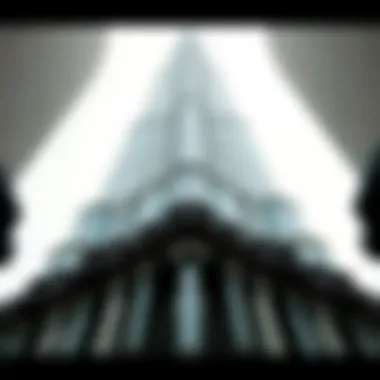
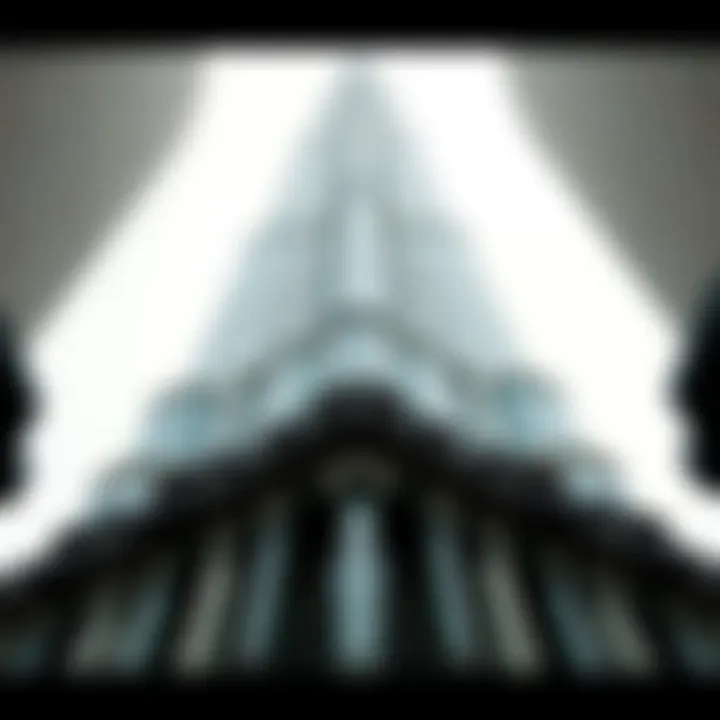
The design and architecture of the Burj Khalifa are at the heart of its iconic stature and influence within the architectural landscape. This section delves into the intricacies and inspirations that formed the design philosophy, highlighting how they align with the structure’s formidable height. The successful translation of artistic vision into a tangible edifice not only establishes aesthetic appeal but also addresses practical considerations in a soaring skyscraper.
Architectural Vision and Concept
The vision behind the Burj Khalifa is both aesthetic and functional. Conceived by architect Adrian Smith of Skidmore, Owings & Merrill, its design is rooted in an interpretation of Islamic architecture, evoking the minarets of local mosques. The structure's elegant, towering silhouette is a nod to the desert flower, the Hymenocallis, with its intricate patterns that simulate natural growth in a conflicting urban environment.
Several distinct design elements stand out:
- Y-Shaped Footprint: This unique base not only supports its monumental height but also provides ample space for the structure.
- Setbacks: The building features a tiered design, with setbacks that not only enhance the aesthetics but also improve wind resistance.
- Cladding System: The exterior is clad in reflective glass and aluminum, designed to reflect the sun's rays and reduce heat absorption.
The concentric circles that drive the building’s structure symbolize unity and embrace the outdoor space, making Burj Khalifa more than a building; it serves as an urban landmark, a beacon of progress and innovation.
Materials Used in Construction
The choice of materials significantly contributes to the durability and safety of the Burj Khalifa. Given its extraordinary height, the building required pioneering materials and construction methods. Here are some key components:
- Reinforced Concrete: The core of the structure is made with high-performance concrete, which ensures strength and stability under the influence of wind and seismic forces. The concrete used was engineered to withstand harsh desert conditions.
- Glass and Aluminum: The façade consists of over 103,000 square meters of glass, designed not only for aesthetic appeal but also energy efficiency. The reflective surface helps control temperature and reduce glare, making it more comfortable for occupants.
- Steel Framework: A robust steel frame bolsters the building's structural integrity, accommodating the expansive height while ensuring safety.
"In architecture, the right materials can bridge the gap between vision and reality. The Burj Khalifa is a prime example where thoughtful material selection yielded a skyscraper that defines a skyline."
In summary, the Burj Khalifa's design and architecture represent a successful fusion of artistic vision, innovative engineering, and practical considerations, culminating in the tallest structure in the world. By marrying form and function, the Burj not only stands tall but also stands out as a symbol of Dubai's ambition.
For those interested in delving deeper into the specifics of Burj Khalifa's architectural design, resources like Wikipedia and Britannica provide insightful additional information.
Engineering Marvel
The Burj Khalifa stands not just as a tower but as a testament to human ingenuity and engineering brilliance. It's crucial to understand the engineering marvel it represents as we explore the confluence of architectural design and structural stability. The challenges posed by such unprecedented height necessitated innovative approaches that have reshaped the way we think about skyscrapers. The structural integrity combined with technological advancements is pivotal in ensuring the safety and sustainability of this towering giant.
Structural Engineering Techniques
The construction of Burj Khalifa introduced several unique structural engineering techniques essential for achieving its height.
- Reinforced Concrete Core: At its heart lies a robust reinforced concrete core that acts like the spine of the building. This core provides stability against lateral forces. Its design is akin to a tree trunk, offering strength while tapering as it rises, minimizing the effects of wind.
- High-Performance Materials: The choice of materials plays a vital role in maintaining the integrity of the structure. The use of a specially formulated concrete mix enabled the building to rise taller than its predecessors while withstanding the harsh desert climate.
- Y-Shaped Floor Plan: The Y-shaped layout creates a natural structural form that maximizes space while reducing wind resistance. This design further enhances the building's rigidity, gracefully guiding airflow around it and reducing pressure on the structure.
These techniques illustrate the careful planning and advanced skills that went into the Burj Khalifa's design.
Wind and Seismic Considerations
Building something of Burj Khalifa's stature isn't without its hurdles, especially when considering wind and seismic forces. Dubai's location subjects the building to high wind speeds, not to mention the occasional seismic activity.
- Wind Tunnel Testing: Engineers conducted extensive wind tunnel tests to understand how the building would react to strong winds. Such tests helped refine the shape of the building to mitigate damage and ensure comfort for occupants.
- Damping Systems: Engineers integrated damping systems within the structure. These systems help absorb and dissipate energy created by wind or seismic forces, akin to how shock absorbers function in a car. This innovation is essential in preventing excessive swaying, which can compromise both structural integrity and occupant comfort.
- Foundation Deepness: A pile foundation was strategically designed to anchor the building firmly into the ground. Extending more than fifty meters into the ground, it provides a solid base that helps counterbalance the repercussions of both wind and seismic events.
Understanding these engineering feats offers a glimpse into the planning and foresight required to achieve the breathtaking height of the Burj Khalifa. Each consideration has not only shaped this monumental structure but has also paved the way for future architectural endeavors.
Cultural Impact
The Burj Khalifa isn't just a structure—it embodies the dreams and aspirations of a city racing towards modernity. This towering piece of architecture stands as a testament to what can be achieved with vision and resilience, influencing not only Dubai but the entire world. The cultural impact of such a landmark extends far beyond its physical height, weaving itself into the very fabric of what defines Dubai's identity.
Burj Khalifa's Role in Dubai's Identity
The Burj Khalifa plays a pivotal role in forging Dubai’s identity. This staggering skyscraper is more than a point on a map; it serves as a symbol of prosperity and ambition. It’s a beacon that draws tourists, investors, and curious minds from across the globe. When you think of Dubai, the image of the Burj Khalifa likely springs to mind, standing tall against the horizon like a proud guardian of the city.
- In a region where growth seemed almost unimaginable decades ago, this building is a clear indicator of the heights Dubai has reached.
- Local culture is intertwined with this architectural wonder. Festivals and events, such as the New Year’s Eve celebrations, often center around the Burj Khalifa, showcasing not just fireworks, but also the unity and spirit of the people.
- The building's design harmonizes with the natural landscape, reflecting cultural motifs while also signaling a new era of urban development.
The Burj Khalifa is not without its controversies; some locals view it as a symbol of excess. However, it cannot be denied that it has redefined the skyline and languages of architecture, letting everyone know that innovation has a home in the heart of the Middle East.
Symbolism of Success and Innovation
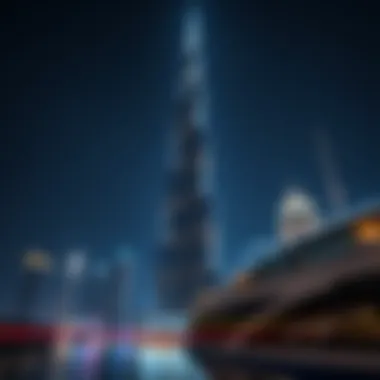

When we talk about the Burj Khalifa, the conversation naturally leans towards success and innovation. This skyscraper stands as a milestone in architectural achievement, representing how innovative engineering can challenge the limits of what is possible.
- Innovation Made Real: The building incorporates cutting-edge technologies in its design and construction. From high-speed elevators that whisk visitors to the observation deck in a matter of seconds to systems that regulate temperature and humidity, every aspect of the Burj Khalifa reflects thoughtful innovation.
- Economic Success: The Burj Khalifa has catalyzed economic growth in Dubai, drawing in tourism and boosting local businesses. The narrative of success extends beyond the building, as its presence has invigorated real estate development and international investments—a boon for the entire economy.
- Cultural Symbolism: Additionally, it represents a broader conversation about the new era of skyscrapers and architectural marvels worldwide. Many upcoming cities and countries refer back to Burj Khalifa as a point of inspiration for their own projects, emphasizing that success is not solely defined by height but by the stories that buildings tell.
"The Burj Khalifa is a voice of Dubai, echoing its aspirations for the future—it's not just about reaching for the sky, but rather about aiming for greatness."
Tourism and Visitor Experience
The Burj Khalifa is not just an architectural marvel; it is a magnet for tourists from around the globe. Its towering height and iconic design serve as beacons, drawing millions to Dubai each year. With its substantial role in shaping the city's tourism landscape, exploring the visitor experience offers fascinating insights into how such landmarks contribute to local economies and cultural identity.
Attraction of Tourists
The allure of Burj Khalifa lies in various aspects that cater to a wide range of visitors. Tourists flock to this skyscraper for multiple reasons:
- Iconic Landmark: The Burj Khalifa's silhouette dominates Dubai's skyline, making it an Instagram-worthy backdrop. Many visitors regard their trip incomplete without a photo in front of this towering giant.
- Cultural Experience: The attraction combines modern architecture with rich cultural experiences. The Souk Al Bahar and the Dubai Fountain nearby provides a blend of shopping and entertainment that enchants tourists.
- Accessibility: The strategic location of Burj Khalifa in Downtown Dubai makes it easily reachable. Proximity to the Dubai Mall and other attractions means that it conveniently fits into wider tourist itineraries.
- Unique Attractions: Visitors are drawn to the building's observation decks like At The Top on the 124th and 148th floors. The chance to stand at such heights, peering down over the expansive cityscape, excites many. As one local put it, "It’s like standing on top of the world."
Sky Observation Deck: A Unique Perspective
One of the most distinctive features of the Burj Khalifa is its sky observation decks, which deliver a perspective unlike any other. Located on the 124th and 148th floors, these decks offer a breathtaking view of Dubai and beyond. The experience is multifaceted:
- Panoramic Views: Visitors can gaze over the sprawling metropolis and see the Persian Gulf glittering in the distance. The views at sunrise and sunset are particularly enchanting, showcasing how the light dances upon the city.
- Innovative Design: The observation decks are designed to enhance visitor experience. Interactive displays provide context to the sights below, making each view informative and engaging. Guests can identify landmarks and even see snippets of live footage from around the city.
- Perfect for Photography: The sleek design and heights encourage visitors to capture and share their moments, fueling social media buzz around the Burj Khalifa. The hashtag #BurjKhalifa does strong business, and many accounts are dedicated to showcasing this iconic structure in all its glory.
Visitor experience at the Burj Khalifa encapsulates a blend of thrill, culture, and stunning visuals. This attraction does not merely stand as a functional building but provides a unique gateway to experiencing Dubai's essence. Thus, the Burj Khalifa serves as a key player in elevating Dubai's global standing as a premier tourist destination.
"Standing on the observation deck, I felt like I could reach out and touch the sky. It was both humbling and exhilarating." - A first-time visitor
For more information about the Burj Khalifa, including visitor tips and ticketing advice, you can check out The Official Burj Khalifa Website or summarize aspects from Wikipedia's Burj_Khalifa page.
Economic Implications
The Burj Khalifa isn't just a towering marvel of architecture; it's also a pivotal player in Dubai's economic landscape. Examining the economic implications of this remarkable skyscraper sheds light on not only its financial benefits but also how its presence transforms local and regional economies. The construction of such an iconic structure has far-reaching effects, impacting various sectors such as real estate, tourism, and urban development.
Real Estate Developments in the Vicinity
The presence of the Burj Khalifa has dramatically influenced real estate developments in its surroundings. Developers have sought to capitalize on the iconic status of the tower, resulting in a proliferation of luxurious residential and commercial properties.
Some key effects include:
- Increased Property Values: Properties near the Burj Khalifa often command premium prices, attracting buyers looking for proximity to such an iconic landmark.
- Luxury Developments: High-end residential complexes, hotels, and retail spaces have sprung up like mushrooms after a rainstorm, aiming to serve both residents and tourists lured by the tower’s fame.
- Global Investment Interest: International investors see the area as a potential goldmine, driving demand and stimulating further developments.
An example of a noteworthy project is the Dubai Mall, which has benefitted immensely from its closeness to the Burj Khalifa. Featuring luxury shops, entertainment venues, and dining options, the mall draws visitors from all walks of life, amplifying its allure.
Impact on Local Economy
The economic impact of the Burj Khalifa extends well beyond immediate real estate developments. Its influence on Dubai’s local economy can be likened to a pebble tossed into a lake, where the ripples affect various facets of economic activity.
Consider the following aspects of its economic footprint:
- Tourism Revenue: The Burj Khalifa attracts millions of visitors each year, leading to substantial income for the tourism sector. Hotels, restaurants, and local attractions benefit directly from the influx of tourists eager to see the world’s tallest building.
- Job Creation: The operation of the building, alongside surrounding businesses, generates a multitude of job opportunities. From hospitality to retail and beyond, many residents find employment due to the thriving economy fueled by the Burj Khalifa.
- Local Business Boom: Small businesses in the vicinity have witnessed increased foot traffic and sales, creating a vibrant commerce scene. This economic uplift has a domino effect, fostering community growth and sustainability.
"The Burj Khalifa has not just changed Dubai's skyline; it has changed its economic landscape, breathing life into sectors that were once dormant."
Sustainability Features
Addressing the topic of sustainability in our built environment has gained unprecedented attention in recent years. This relevance pivots around the need to create structures that not only push the boundaries of architectural design but also contribute positively to their surroundings. The Burj Khalifa serves as a beacon in this regard, integrating sustainable technologies that ensure its operation is congruent with a commitment to environmental stewardship. The overarching goal is to balance the majestic height of the structure with principles that safeguard the ecological integrity of its locale, setting a benchmark for future skyscrapers.
Energy Efficiency Measures
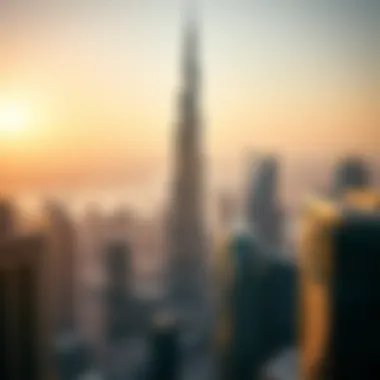
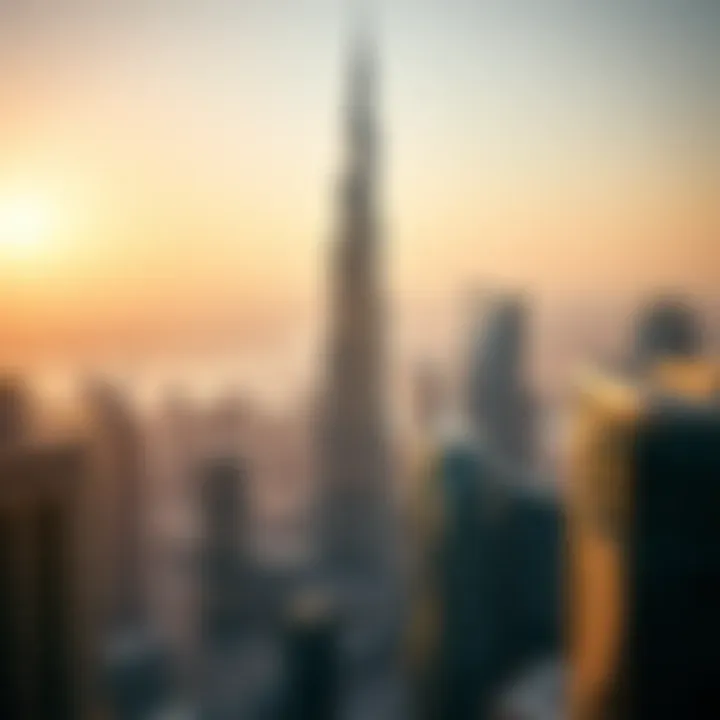
The Burj Khalifa has set high standards when it comes to energy efficiency. Its design minimizes energy consumption while maximizing comfort for its occupants. Central to this effort is the use of advanced glass, which has a coating that considerably reduces solar heat gain. This not only allows for natural light penetration but also curtails the reliance on artificial lighting during daylight hours. To put it plainly, it’s like letting the sun do most of the work, significantly lowering electricity demands in the process.
"Burj Khalifa is a prime examples of how we can integrate energy efficiency into high-rise design." cite: en.wikipedia.org
Moreover, the building is equipped with an intelligent control system that monitors and optimizes energy usage throughout the day. By employing energy rings that harness excess power and feed it back into the grid, the Burj Khalifa not only sustains itself but contributes to the overall energy security of Dubai.
Additionally, an innovative chilled water system includes pumps that operate at variable speeds, which decreases energy utilization during off-peak demand periods. The whole setup acts like a finely-tuned orchestra, where each component plays its part to deliver optimal performance while keeping energy waste at bay.
Water Conservation Strategies
Water conservation is another critical sustainability feature of the Burj Khalifa. In a city like Dubai, where water is a precious commodity, the building employs sophisticated strategies to manage this resource smartly. A striking element is the recycling of water used during construction, which has been repurposed to irrigate the surrounding landscapes once the building was completed. This practice not only lessens the environmental impact but also beautifies the area while promoting biodiversity.
Beyond initial construction, the Burj Khalifa utilizes several sophisticated water-efficient technologies. Its plumbing systems incorporate fixtures that minimize water flow without compromising user experience. This approach extends to irrigation systems that utilize drip technology to ensure precise watering of greenery, avoiding over-saturation and waste.
In essence, the water conservation strategies employed in the Burj Khalifa reflect a profound awareness of regional challenges. The idea is straightforward: every drop counts in an arid environment, and innovative practices have given this architectural marvel not just stature but also a significant role in enhancing local sustainability efforts.
Together, energy efficiency and water conservation measures bolster the Burj Khalifa's standing as an exemplary model for future constructions in urban settings worldwide. By considering both the operational and environmental aspects, it fosters a dialogue about the intertwining paths of architectural grandeur and sustainable living.
Future of Tall Buildings
The conversation around the future of tall buildings stays particularly relevant in the context of evolving urban landscapes. The Burj Khalifa serves as a benchmark and a source of inspiration for architects and engineers worldwide. As cities grow, verticality has become a solution to land scarcity, and it raises essential questions about sustainability, functionality, and innovation.
Key elements to consider in the discussion about the future of skyscrapers include:
- Sustainability Innovations: As environmental concerns escalate, incorporating sustainable practices into building designs is pivotal. Many upcoming skyscrapers are expected to feature green roofs, energy-efficient systems, and cutting-edge materials that minimize waste.
- Technological Advancements: Smart buildings are on the rise. The integration of IoT devices for building management boosts efficiency and user experience. Technologies that monitor energy consumption and optimize resource use are critical as we navigate our urban future.
- Human-Centric Design: Future tall buildings must prioritize the well-being of occupants. This could entail thoughtfully designed mixed-use spaces that enhance social interaction or promote mental health through accessible outdoor areas.
In essence, skyscraper development is not just about height; it’s about creating livable spaces that meet contemporary needs while facing future challenges.
Lessons from the Burj Khalifa
The Burj Khalifa has imparted numerous lessons on how tall buildings can effectively respond to various challenges while setting the standard for others to follow. One fundamental insight is the importance of rigorous testing and simulation prior to construction. From wind resistance studies to seismic testing, understanding the forces at play is crucial for safety and durability.
"Lessons drawn from the Burj Khalifa have framed our approaches toward designing safe and functional skyscrapers for the future."
Another key takeaway is the blend of aesthetic and practical functionalities. Designers learned the power of mixed-use spaces in promoting vibrant urban life, as seen with the Burj's combination of residential, office, and hospitality functions within its height. This kind of foresight helps in transforming skylines and fostering community.
Potential Innovations in Skyscraper Design
Looking ahead, several innovative concepts are reshaping skyscraper design. For instance, modular construction techniques are gaining traction, enabling buildings to be manufactured in sections before being assembled on-site. This can substantially reduce construction time and waste.
Other noteworthy trends include:
- Vertical Farms: The integration of agricultural practices within skyscrapers could greatly enhance urban food security and reduce transportation emissions.
- Adaptive Reuse: As many cities evolve, there’s a push toward repurposing existing structures rather than demolishing them. New designs can breathe life into old buildings, resonating with the growing demand for sustainability.
- Elevated Urban Spaces: Future skyscrapers might feature parks and public spaces that encourage outdoor experiences at different heights, thus contributing to mental health and leisure.
Culmination
The conclusion of any deep dive into a subject like the Burj Khalifa holds substantial weight. It serves as the final round-up, tying together all facets of this remarkable skyscraper while offering valuable insight into its larger implications. This article does far more than just present facts about the building's height and features. It uncovers how the Burj Khalifa reflects the aspirations of those who built it and the city it occupies, serving as a beacon of innovation in urban design.
Reflecting on Its Legacy
Burj Khalifa stands not only as a physical structure but also as a narrative woven into the fabric of Dubai's identity. The building has left an indelible mark on the global scene, showcasing what is possible with ambition and technological advancement. From a cultural standpoint, it has become a symbol of modernity and success in a world that often juxtaposes tradition against relentless progress.
Visiting the Burj Khalifa is akin to stepping into a dialogue between the past and the future. The skyscraper invites reflection on how urban landmarks can influence lifestyle and societal aspirations. It challenges other cities to elevate their ambitions and consider how architecture shapes collective experiences.
"The Burj Khalifa is more than just a tall building; it's a testament to human ingenuity and an inspiration for future architects everywhere."
Final Thoughts on Urban Landmarks
Urban landmarks like the Burj Khalifa do not merely exist in isolation; they evolve as part of a city's narrative. The Burj Khalifa is not just about height; it’s about how such structures can enrich people's lives, enhance tourism, and catalyze economic growth. As cities around the world grapple with increasing populations and dwindling space, the lessons learned from the Burj Khalifa become ever more pertinent.
What, then, is the take-home message? Investing in such landmarks yields benefits that go beyond aesthetics. It shows a commitment to innovation. With the right vision, these structures can act as both anchors and beacons, guiding cities toward a sustainable future. In a world increasingly focused on skyscrapers and urban development, bringing creativity and sustainability to the forefront is critical for forthcoming generations.
In summary, analyzing the Burj Khalifa’s height and design brings to light not only technical mastery but also the aspirations of humanity itself. As we step forward into future urban landscapes, we should keep in mind the importance of holistic development—one that balances beauty, functionality, and environmental awareness.
